| XXII Corps | |
|---|---|
 XXII Corps formation badge. | |
| Active | World War I |
| Country | |
| Branch | |
| Type | Field corps |
| Part of | First Army |
| Engagements | World War I |
The British XXII Corps was a British infantry corps during World War I.
| XXII Corps | |
|---|---|
 XXII Corps formation badge. | |
| Active | World War I |
| Country | |
| Branch | |
| Type | Field corps |
| Part of | First Army |
| Engagements | World War I |
The British XXII Corps was a British infantry corps during World War I.
British XXII Corps was formed in France in December 1917, from what was left of II ANZAC, once the Australian divisions had left to form the Australian Corps. [1] In July 1918, significantly reconstituted as an inter-Allied reserve corps, by the addition of four first-line British Army divisions, the 15th (Scottish) Division, the 34th Division, the 51st (Highland) Division and the 62nd (West Riding) Division. It was placed under French command in July 1918 prior to the German "Friedensturm" (Peace Offensive). The Corps played an important role in the "pinching-off" of the Soissons–Rheims salient (which had been established by the German "Bluecher" Offensive in late May 1918) in the Second Battle of the Marne. [2] Two divisions (15th, 34th) went into action with the French Tenth Army (Mangin) against the Soissons "hinge", two (51st, 62nd) in the Ardre valley with the French Fifth Army (Berthelot) against the Rheims "hinge".
XXII Corps was returned to Haig’s command in early August 1918 to help him bring forward the start date for the Amiens offensive. [3]
Commanders included:

The Second Battle of the Marne was the last major German offensive on the Western Front during the First World War. The attack failed when an Allied counterattack, led by French forces and supported by several hundreds of Renault FT tanks, overwhelmed the Germans on their right flank, inflicting severe casualties. The German defeat marked the start of the relentless Allied advance which culminated in an armistice with Germany about 100 days later.

British Army of the Rhine (BAOR) was the name given to British Army occupation forces in the Rhineland, Germany, after the First and Second World Wars, and during the Cold War, becoming part of NATO's Northern Army Group (NORTHAG) tasked with defending the North German Plain from the armies of the Warsaw Pact. The BAOR constituted the bulk of British forces in West Germany, and was a part of British Forces Germany (BFG). The BFG was made up of elements of the three services based in West Germany; the BAOR controlled Army units stationed there.

I Corps was an army corps in existence as an active formation in the British Army for most of the 80 years from its creation in the First World War until the end of the Cold War, longer than any other corps. It had a short-lived precursor during the Waterloo Campaign. It served as the operational component of the British Army of the Rhine during the Cold War, and was tasked with defending West Germany.

IX Corps was a corps-sized formation of the British Army that existed during the First and the Second World Wars.
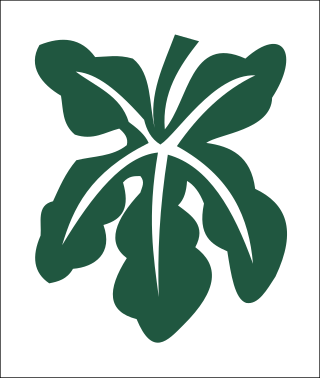
III Corps was an army corps of the British Army formed in both the First World War and the Second World War.

The Third Army was a field army of the British Army during World War I that saw active service on the Western Front throughout the war.

The Battle of Amiens, also known as the Third Battle of Picardy, was the opening phase of the Allied offensive which began on 8 August 1918, later known as the Hundred Days Offensive, which ultimately led to the end of World War I. Allied forces advanced over 11 kilometres (7 mi) on the first day, one of the greatest advances of the war, with Gen Henry Rawlinson's British Fourth Army, with nine of its 19 divisions supplied by the fast-moving Australian Corps of Lt General John Monash and Canadian Corps of Lt General Arthur Currie, and Gen Marie Eugène Debeney's French First Army playing a decisive role. The battle is also notable for its effects on both sides' morale and the large number of surrendering German forces. This led Erich Ludendorff to later describe the first day of the battle as "the black day of the German Army". Amiens was one of the first major battles involving armoured warfare.
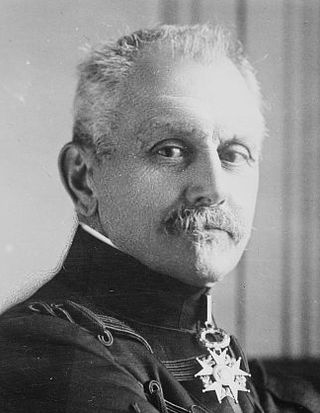
Michel-Joseph Maunoury was a commander of the French forces in the early days of World War I who was posthumously elevated to the dignity of Marshal of France.

The Third Battle of the Aisne was part of the German spring offensive during World War I that focused on capturing the Chemin des Dames Ridge before the American Expeditionary Forces arrived completely in France. It was one of a series of offensives, known as the Kaiserschlacht, launched by the Germans in the spring and summer of 1918.

The Battle of Soissons (1918) was fought on the Western Front during World War I. Waged from 18 to 22 July 1918 between the French and the German armies, the battle was part of the much larger Allied Aisne-Marne counter-offensive. It followed the final German Spring Offensive, Operation Marneschutz-Reims. The primary objective of the attack was to cut both the Soissons – Château-Thierry road and the railroad running south from Soissons to Château-Thierry. As these were the main supply routes for the German forces in the Marne salient, cutting them would severely impair the Germans' ability to supply its armies defending it. This would force them to retreat and give up their gains. This battle marked the turning point of the war as the Germans would be on the defensive for the remainder of the conflict.
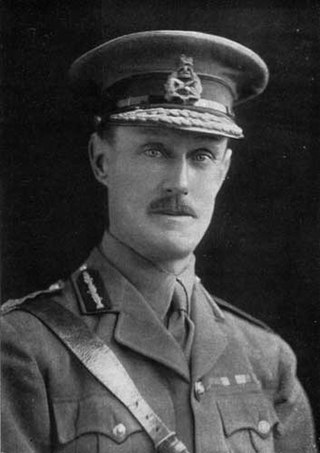
General Sir Alexander John Godley, was a senior British Army officer. He is best known for his role as commander of the New Zealand Expeditionary Force and II Anzac Corps during the First World War.

The United States campaigns in World War I began after American entry in the war in early April 1917. The American Expeditionary Force (AEF) served on the Western Front, under General John J. Pershing, and engaged in 13 official military campaigns between 1917 and 1918, for which campaign streamers were designated. The streamer uses the colors of the World War I Victory Medal ribbon which had a red center with a rainbow on each side of the center stripe and a purple edge. The double rainbow symbolizes the dawn of a new era and the calm which follows the storm.
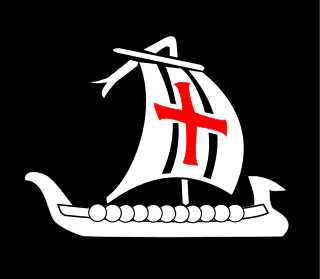
V Corps was an army corps of the British Army that saw service in both the First and the Second World Wars. It was first organised in February 1915 and fought through the First World War on the Western front. It was recreated in June 1940, during the Second World War and was substantially reorganised in 1942 for participation in Operation Torch. It fought through the Tunisia Campaign and later the Italian Campaign.

Buzancy is a commune in the department of Aisne in Hauts-de-France in northern France.

Marie Eugène Debeney was a French Army general who fought in the First World War. He commanded a corps at the Battle of the Somme in 1916 then, in the second half of 1917, served as chief of staff to the French Commander-in-Chief Philippe Pétain. He then commanded the First Army which, fighting alongside British Empire forces, played an important role in the mobile fighting of 1918, including at the Battle of Amiens and the Storming of the Hindenburg Line.

Henri Mathias Berthelot was a French general during World War I. He held an important staff position under Joseph Joffre, the French commander-in-chief, at the First Battle of the Marne, before later commanding a corps in the front line. In 1917 he helped to rebuild the Romanian Army following its disastrous defeat the previous autumn, then in summer 1918 he commanded French Fifth Army at the Second Battle of the Marne, with some British and Italian troops under his command. In the final days of the war he again returned to Romania, helping fight the Hungarians during the Hungarian–Romanian War and then briefly commanded French intervention forces in southern Russia in the Russian Civil War, fighting the Bolsheviks in Bessarabia (1918).

This is the order of battle for the Battle of the Somme. The Battle of the Somme was an offensive fought on the Western Front during World War I from 1 July to 18 November 1916 as one of the greatest engagements of the war. It was fought between French, British and Dominion forces and the German Empire in the Somme River valley and vicinity in northern France.
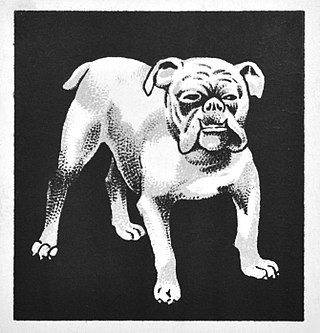
VI Corps was an army corps of the British Army in the First World War. It was first organised in June 1915 and fought throughout on the Western Front. It was briefly reformed during the Second World War to command forces based in Northern Ireland, but was reorganized as British Forces in Ireland one month later.

This is the order of battle for Operation Michael, part of the German Spring Offensive fought from 21 March to 5 April 1918 as one of the main engagements of the First World War. It was fought between mixed French, British and Dominion forces and the German Empire in the Somme region in northern France.
The II ANZAC Corps Mounted Regiment was a combined mounted unit made up of Australian and New Zealand troops during the First World War. The regiment served on the Western Front between 1916 and 1918. For the most part, the regiment undertook rear area duties, although it undertook more mobile operations in early 1917 during the German withdrawal to the Hindenburg Line. In November 1917, the regiment was redesignated as the XXII Corps Mounted Regiment when II ANZAC Corps was converted into XXII Corps. During early 1918, the regiment played a defensive role during the German spring offensive and then supported French operations during the Second Battle of the Marne. The regiment continued operations throughout the remainder of 1918, supporting the Allied Hundred Days Offensive until the end of the war.